January 1912 at Shoreham Aerodrome saw flying schools getting established, as reported in Flight Magazine- 06-01-1912
Brighton-Shoreham Aerodrome
Last weekend has seen the successful completion of two machines, the Collyer-England tractor biplane and the Chanter monoplane. The first named made straight flights on Saturday and Monday, with Dowland in control, and was put through a fair amount of rolling by both England and Dowling. Mr M. Chanter took his new monoplane out on Monday, and was in the air with her shortly after leaving the shed. On Tuesday she was out again, under the pilotage of her owner, and gave still better results. Ross, Gattler, Kent, and Davies, were out on the Chanter school Bleriots.
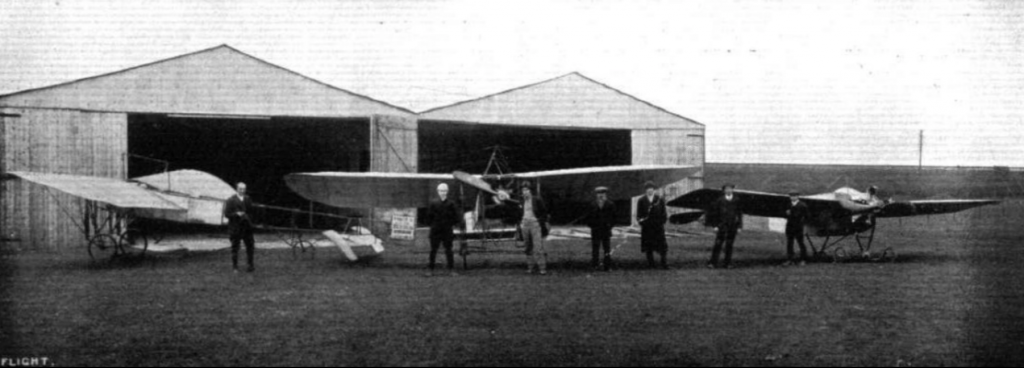
The Chanter Flying School at Shoreham, with their two Anzani-Bleriots and their 35-h.p. monoplane modelled on Nieuport lines. At the left-hand side is Mr. M. Chanter, the Director of the school. To the right are Messrs. De Villlers, Gassier, Kent, Ross, and two of the school mechanics.
A week later, Flight Magazine, 13-01-1912, informs its readers of a significant addition proposed at Shoreham:-
‘Things are moving apace at the Brighton-Shoreham Aerodrome. In order that shedholders may be on the spot and able to avail themselves of every period of early morning calm, a clubhouse is shortly to be erected. A view of this building as it will appear when completed appears elsewhere in this issue. It is intended to furnish 20 bedrooms for their use and two billiard rooms, each with two tables, are to be provided. Good luck to such sound enterprise.’
With Flight Magazine keeping tabs on aviation progress around the country, Shoreham continued to receive coverage of its advancement on a weekly basis, here is their report for the week ending 20th Jan 1912:-
Brighton-Shoreham Aerodrome
Practically every day last week has seen outdoor work going on. The Chanter school was very busy on Wednesday, the 10th, Kent got off the ground for the first time, and made a very steady straight flight on the Bleriot. Gassler and De Villiers were both up several times, and Hamilton-Ross put in a flight or two both on Wednesday and Thursday. On Friday, Gassler was doing a long flight in splendid form on one of the school Bleriots, but had the misfortune to run in to the wire fence between the hangars and the restaurant, damaging the machine but escaping unhurt himself. Saturday saw Chanter doing cross country work on the 40-h.p Anzani-Bleriot. In the gathering dusk his flying was brought to an untimely end by a down current of air which caused a rather abrupt landing in a field adjoining the Lancing College. The machine was smashed, but Mr Chanter was unhurt, having been thrown clear.
The Collyer- England machine has been undergoing an overhaul, and has only appeared outside on two occasions. On Wednesday England had her up and down the ground several times, and on Thursday Dowland was testing her. A cheer was raised when this neat biplane came spinning towards the sheds “two up”.
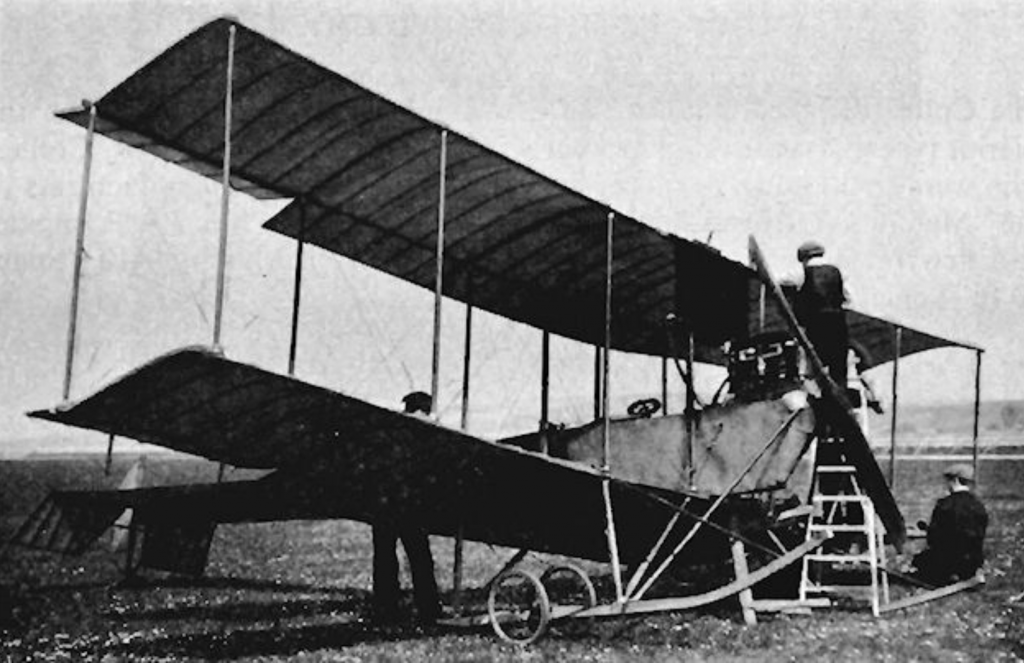
Also in this edition, the magazine reports on Lieutenant Walter Lawrence’s movements in the ‘Air Eddies’ section:-
Lieut. Lawrence, of the 7th Essex Regiment, who was recently reported in the daily press as intending to cross the channel with miss Lottie Paine, one of the nuns appearing in “The Miracle” at Olympia, as passenger, has been for the past week at Filey, where he has been gaining experience on the Blackburn monoplane. By the time these lines appear in print he expects to be settled at Shoreham with one of the Blackburn school machines, which the firm has, in a very sportsmanlike manner, placed at his disposal, until he obtains delivery of the Blackburn two seater for which he has placed an order.
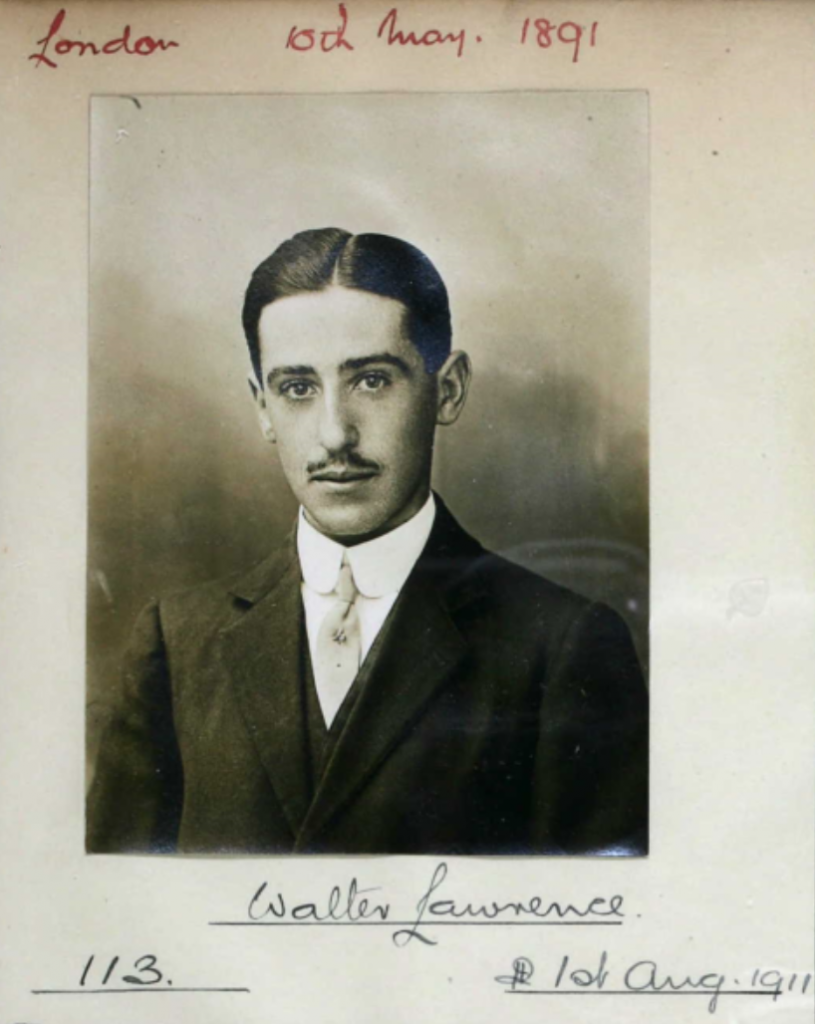
Issued by the Royal Aero Club.
In the January 18th edition of ‘The Aeroplane’, there is mention of the going’s on at Shoreham, and a photograph of Oscar Morison moving his Bleriot machine from the aerodrome back in the summer, with D. G. Gilmour standing in front of his car, a fine example of the transportability of these early ‘kites’:-
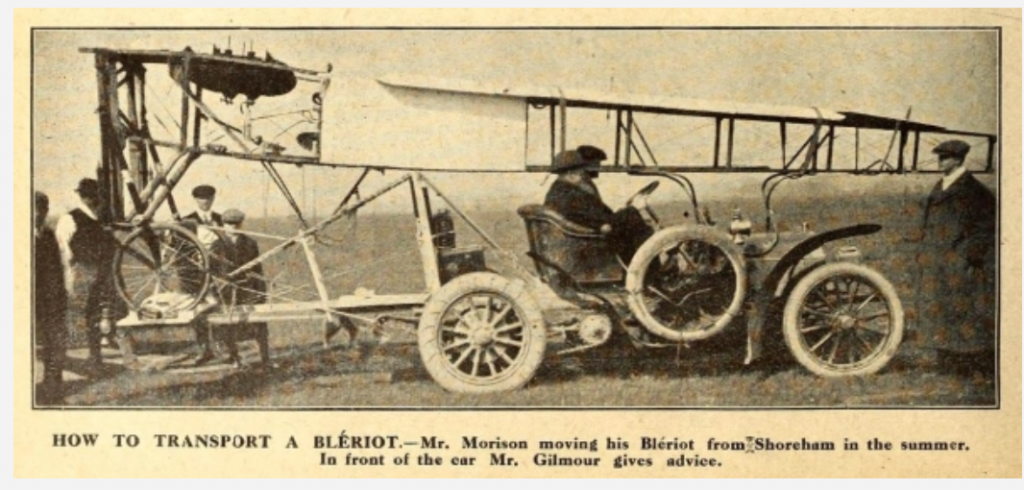
Meanwhile, local newspaper, Brighton Gazette Saturday 27th January 1912, reports on movements at Shoreham Aerodrome:-
Aviation at Shoreham
The “Blackburn” passenger carrying monoplane, expected at the Brighton-Shoreham aerodrome from the north of England, arrived at Shoreham-by-Sea Station on Thursday, and Lieutenant Lawrence, who is flying this make of aeroplane, towed it over to the Aerodrome behind his motor car. As already announced, he will be staying there for a time
The last January report for Shoreham in Flight Magazine, 27-01-1912, is a brief summary of the weeks events.
Brighton-Shoreham Aerodrome
By the time this appears in print, Lieut. Walter Lawrence should have his Blackburn monoplane and have put in some good flying here.
Messrs. M. Chanter and Co’s staff have been busy getting the Bleriot’s into flying order again, and one of the machines will be at work again before the end of the week.
A 35-h.p Green is being fitted in the Collyer-England biplane as the machine has proved its worth and promised excellent results if provided with more power. Great things are looked for when she comes out again this weekend.
February saw the continuance of increasing activities at Shoreham, with the recently built hangars at near full capacity, and as always, Flight Magazine, 03-02-1912, following the aerodrome’s progress :-
Brighton-Shoreham Aerodrome
On Thursday last week the 25-h.p Anzani-Bleriot was brought out by Kent, who put in a short time at rolling practice, while Chanter was continuing the test of his new monoplane. Lieut. Walter Lawrence arrived with the Gnome-Blackburn monoplane, which has been placed at his disposal pending the completion of the passenger machine the Blackburn Company has on order for him.
On Saturday the machine was ready for working, and Lieut. Lawrence took his seat in the machine and had a rollover the ground, then did a straight flight. This was his first experience in the monoplane.
Sunday being an ideal day for flying, the Blackburn was brought out early, and Lieut. Lawrence did a little practice in her, getting accustomed to the control, and putting in some good work. During the morning, Mr B.C. Hucks took the Blackburn in hand, and, rising very quickly in to the air, made several splendid circuits, but had to come down on account of the carburettor freezing, and alighted on a piece of land outside the aerodrome. After lunch, Mr Hucks flew back in to the aerodrome and di a very fine flight. He then took Mr Blackburn up as a passenger.
Next day Lieut. Lawrence did straight flights, making excellent progress with his new mount. The Collyer-England machine has been out with a Green engine, but is not tuned up to the satisfaction of her owner yet.
Tuesday was a very busy afternoon. Lieut. Lawrence getting the Blackburn out, and rising very quickly from the ground, covered three 5 mile circuits in splendid fashion, climbing to an altitude of 1,000 ft. He vol planed, and landed very easily. The Collyer-England was brought out, and some good work put in. Mr Chanter had his new monoplane out, but after doing several runs could not get the engine to work properly. The 25-h.p. Anzani-Bleriot was also brought out, but only did rolling practice, as the engine was not working satisfactorily.

In what would prove to be a tragic week for the aviation world, progress continued at Shoreham, with Flight Magazine:- 24-02-1912, relaying the events to its eager readers of the previous week:-
During the early part of last week most of the machines were in the sheds for various reasons. The C.E biplane was having her new tractor made and fitted, the Chanter monoplane undergoing sundry minor adjustments with a view to still further increasing her efficiency, while the Blackburn was in the final stages of repair after the mishap of the 3rd.
Wednesday saw the C.E biplane up, England and Dowland in turn at the control. She is much improved with her new tractor. On Friday, further flights were put in, but the last landing resulted in a buckled wheel, which rendered the machine hors de combat for the day.
Lieut. Lawrence was on the wing again on Saturday, the Blackburn being finished. A trial flight of 3 miles in the morning proved so satisfactory that a trip to Brighton was arranged for the afternoon. At about 3.45, Lieut. Lawrence left the ground and rapidly gained the height of 1,500 feet. When passing over the front at Brighton, handbills were thrown from the machine, to be eagerly caught up as they reached the ground, it being the first time this form of advertising has been tried in this district. The trip lasted 22 minutes, and was brought to a very successful close with a graceful vol plane.
One of early Shoreham aerodrome’s most colourful characters, Douglas Graham Gilmour, suffered a fatal accident while flying out of Brooklands Aerodrome on Saturday 17th Feb 1912. He was a hugely popular pioneer of aviation, whose untimely death was reported widely throughout the world to a greatly saddened public, but he was always prepared for such an eventuality, as following newspaper reports, and friend’s testimonies, will show.
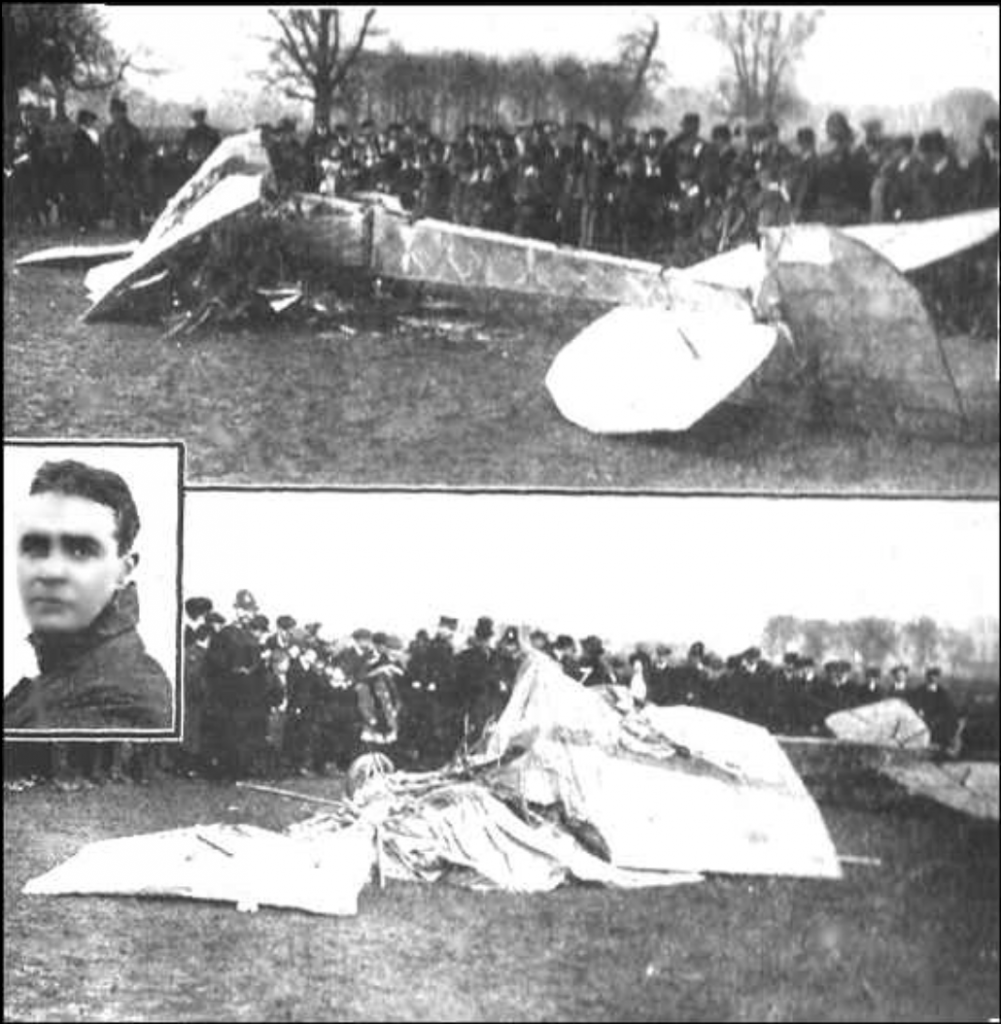
Here is the report from The Yorkshire Evening Post, Tuesday, February 20, 1912:-
THE DEAD AVIATOR. GILMOUR’S ARRANGEMENTS FOR HIS FUNERAL. “NO MOANS OR TEARS”. ONLY COLOURED FLOWERS TO LIE ON HIS GRAVE. SEALED LETTER OPENED ON HIS DEATH
Mr Graham Gilmour, the daring young aviator who was killed on Saturday at Old Deer Park, Richmond, wrote a letter last May, and sealed it, giving instructions that it was not to be opened except in the case of his death.
This letter it appears, contained his wishes with regard to his funeral arrangements. It is requested that no bell is to be tolled, and that there is to be “no mourning and no moaning”
If any flowers were to be sent they were to be coloured ones; his body to be conveyed on a four wheeled farmers cart, or a motor lorry. He also wished to be buried with his mother and father at Mickleham Church.
Further on in the article it reads as follows:-
Evidence of identification was given by Mr Staples Firth, of Upper Tulse Hill. He said Mr Douglas Graham Gilmour would have been 27 years of age next month, and had been brought up as an engineer. He was also an aeronaut, and resided at Bookham, Surrey. He had been deceased’s solicitor, and also a personal friend for some years. When he saw him last Thursday he seemed in his usual condition, but perhaps was a little run down. He was very active and vigorous, added the witness, who paused, and then said in a low voice, “and a very courageous man”.
NOT FOOLHARDY OR RECKLESS
Answering questions, Mr Firth said deceased was an expert in flying, and was not foolhardy or reckless. He calculated all that he did in relation to his flying. Deceased told witness that it was his practice to make a minute inspection of his own machine before he went up. “He had no trouble?”, asked the Coroner. “No” Mr Firth replied. “He had everything in perfect order”.
Later that year it is revealed that Gilmour wrote his will out on headed paper of the Royal Albion Hotel, Brighton, one of Harry Preston’s hotels, while staying there around the time when he and Eric Cecil Gordon England flew from Shoreham to Hove lawns on the 21st May, 1911, nearly dunking in the sea after engine failure. Perhaps it was this incident which made Gilmour think about writing a will.
Nottingham Daily Express, Friday, May 24, 1912
“Graham Gilmour’s Will
The will has now been proved of Mr Douglas Graham Gilmour, the famous aviator, who was killed whilst flying over the Old Deer Park, Richmond, on February 17th last, at the age of 26 years. His will was made on a sheet of notepaper, with the Royal Albion Hotel (Brighton) heading, is dated May 25th, 1911, and reads as follows:-
“I leave everything to Mrs Marcia Milbank, and wish her to pay Mrs. Moor, of 80, Maida Vale, W., per cent. of the income until Mrs. Moor’s marriage or death. Trustees:- T. W. S. Pollok and Staples Firth.”
The will is witnessed by Mr. H. R. Preston, (Hugh Richard Preston), proprietor of the Royal Albion Hotel, Brighton, and Mr. H. J. Preston (Harry John Preston). As he named no executor of his will, letters of administration with the will annexed of his property have been granted to Marcia, wife of Robert Charles Milbank of Goose Hill, Martock, Somerset, by whom Mr Gilmour’s estate has been sworn for probate as of the gross value of £22. 10s”
As it ever was with the growing world of aviation, life went on, and Lieutenant Lawrence, as if to emphasise the ever present danger of aviation at the time, nearly comes to grief on a flight from Shoreham to Eastbourne, covered by Flight Magazine, 2nd March, 1912:-
Brighton-Shoreham Aerodrome
On Saturday last the flying conditions were ideal the greater the part of the day, and Lieut. Lawrence gave exhibition flights during the morning. The C.E biplane has been putting in good work and is proving a very manageable machine, she is extremely steady and answers readily to her controls; she would be an excellent ‘bus for school purposes. On Monday morning Lieut. Lawrence flew to Eastbourne on the Blackburn monoplane, covering the 32 miles in 26 minutes, there being a following wind which increased from 8 m.p.h when he left Shoreham, to about 30 m.p.h. by the time he landed. As he approached Eastbourne, at an altitude of 2,500 ft, his engine failed and he was forced to come down on the beach, and although several ballast trucks were right in the path of the forced vol plane he managed to elevate the machine sufficiently to clear them and so landed without damage. The fact that Lieut. Lawrence has only recently taken to the monoplane, this being but his seventh flight on this type, speaks volumes for the capabilities of this popular officer as well as for the efficiency of the machine, which, by the way, is the same B.C. Hucks used for his tour in the west of England and the Circuit of Great Britain.
It may well have been Lieut. Lawrence that was spotted by crowds on Brighton seafront on this occasion, as reported in the Brighton Gazette of Wednesday 21st Feb:-
“It was a curious coincidence that almost as soon as the sad news of the disaster to Mr. Graham Gilmour had spread among the crowds on the Sea Front, an aeroplane was discerned approaching from the direction of the Shoreham Aerodrome, and public attention was rivetted upon the movements of the aviator. He was advancing rapidly against a headwind, and was soon over the West Pier, proceeding eastwards about three hundred feet above the channel. It was apparently one of the new type of monoplane, tapering off into a kind of dolphin tail. It struck observers that the motion was wonderfully steady, and that the aviator had complete control over the machine. Off West Street, the pilot turned inland, and passing behind the Grand Hotel and the Hotel Metropole, once more made for the line of the shore, and sailed away at a terrific rate for Shoreham, soon being lost in the haze.”
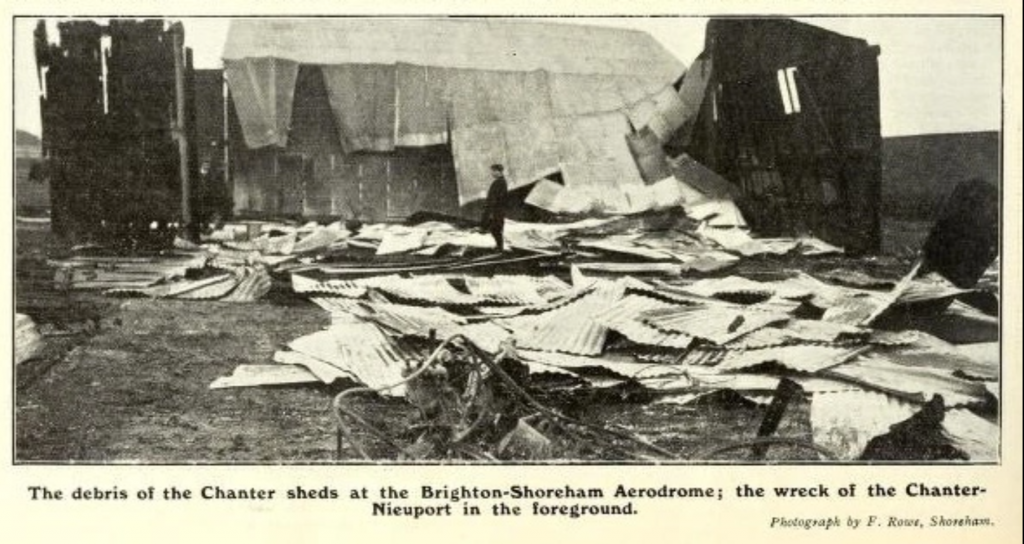
At the end of February, disaster befell Shoreham Aerodrome, and chiefly Chanter and Co flying school, while Lieut. Lawrence’s plane had a very lucky escape, reported in Flight Magazine of March 9th 1912:-
Brighton-Shoreham Aerodrome
Three aeroplanes have been lost as result of the disastrous fire which broke out in the sheds on February 29th. Some employees were saying goodbye after a Leap Year ball at the Town Hall on the early morning of February 29th when they observed flames in the direction of the aerodrome. Making their way thither they found a furious fire raging and involving three of the hangars. In order to keep the fire under control a fourth hangar was pulled down. The three aeroplanes destroyed were a Nieuport and two Bleriots belonging to Messrs Chanter and Co. which were housed in two of the sheds, while the third shed, which usually housed Lieut. Lawrence’s Blackburn machine, was empty. Damage is estimated at over £1000.
The Brighton Gazette also covered the story in their Saturday 2nd March edition, here is a part of their coverage:-
Big Fire at Shoreham Aerodrome
Meanwhile the Shoreham Fire Brigade arrived on the scene, and the work of isolating the flames, rescuing aeroplanes and other articles from the hangars yet intact, and getting the fire under was assiduously proceeded with. Chemical fire extinguishers were brought into action, and buckets of water poured on the buildings. It was touch and go as far as the fourth hangar was concerned, but by cutting down a portion, the fire was kept away from the remainder of the block. The Brigade got the fire under by about four o’clock. Three aeroplanes were destroyed, including a Nieuport and two Bleriots. Two engines were also destroyed, while among other effects lost were the tools of the mechanics, which are of a somewhat valuable character. The three machines taken out of the other hangars included Mr England’s aeroplane and the Metzgar-Leno monoplane. Mr Wingfield and Mr Pettett (Manager of the Aerodrome) were also apprised of the occurrence and came over from Brighton.”
It would appear that all did not go smoothly with the rebuild of the destroyed hangars, resulting in the builder, John Joseph McManus of Brighton, taking the proprietors of the aerodrome to court:-
Brighton Gazette Saturday 18th May 1912
Shoreham Aerodrome
Brighton Builder’s Appeal
In the Court of Appeal on Tuesday before Lords Justices Vaughan Williams, Fletcher Moulton, and Farwell, the appeal was heard of Mc Manus v the Brighton-Shoreham Aerodrome, Ltd. And another, on the plaintiff’s appeal from an order by Mr. Justice Bucknill in chambers. The plaintiff, Mr. John Joseph McManus, a builder and contractor, of Brighton, sued the defendants, originally known as Aviators Finance, Limited, for work done and material supplied in connection with work at the aerodrome. The plaintiff had received £500 in cash, and £400 in debentures, and he claimed that there was now owing a balance of £1,069 15s 10d. The defendants pleaded that the work had not been done according to specifications, that it was not left in a stable and proper condition, and that the plaintiff had used inferior and cheaper material. They also stated that plaintiff had been guilty of breach of contract, but all these and other allegations the plaintiff denied.
The plaintiff made an application before Master Chitty that certain portions of the defence should be struck out, on the ground that they were unnecessary, and tended to prejudice the trial. The Master refused to do this, and plaintiff then appealed to Mr. Justice Bucknill in Chambers, who dismissed the appeal, upholding the order of the Master. Against this plaintiff now appealed. The Court dismissed the appeal with costs, the appellant to pay the costs in any event.
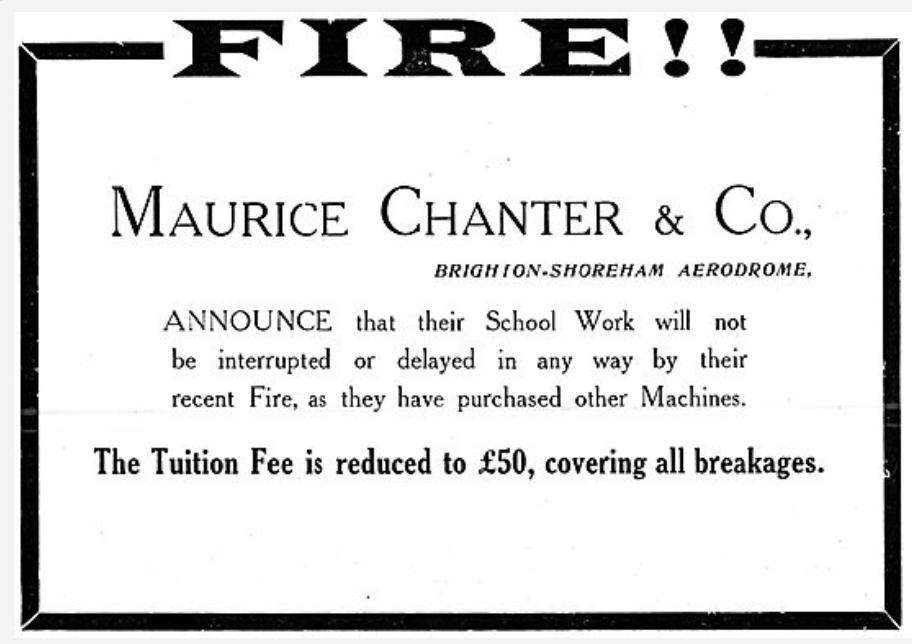
Maurice Chanter took out an advert to alert the world of aviation that despite their losses in the fire, his flying school would continue as before.
Shoreham continued to attract the stars of the air regardless, with Pierre Verrier coming down on his Maurice Farnham biplane, on which he managed a creditable 4th position in ‘The Aerial Derby’ held at Hendon on 8th June in front of 45,000 spectators despite pouring rain on the day, proving again that aviators really were the brightest stars of this era.
Northern Whig Monday 8th July 1912
M. Verrier, on a Maurice Farman biplane, and having as passenger his mechanic, left Hendon Aerodrome for Brighton at 4.15 yesterday afternoon. He reached the Shoreham Aerodrome, Brighton, a 5.35.
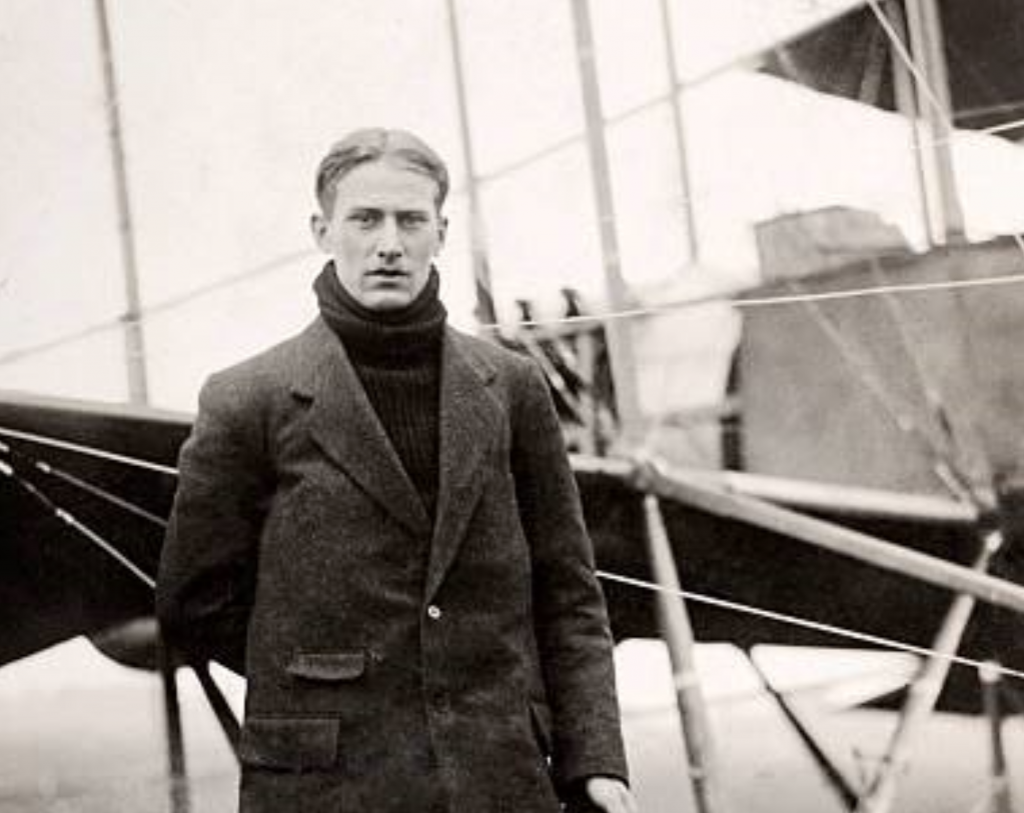
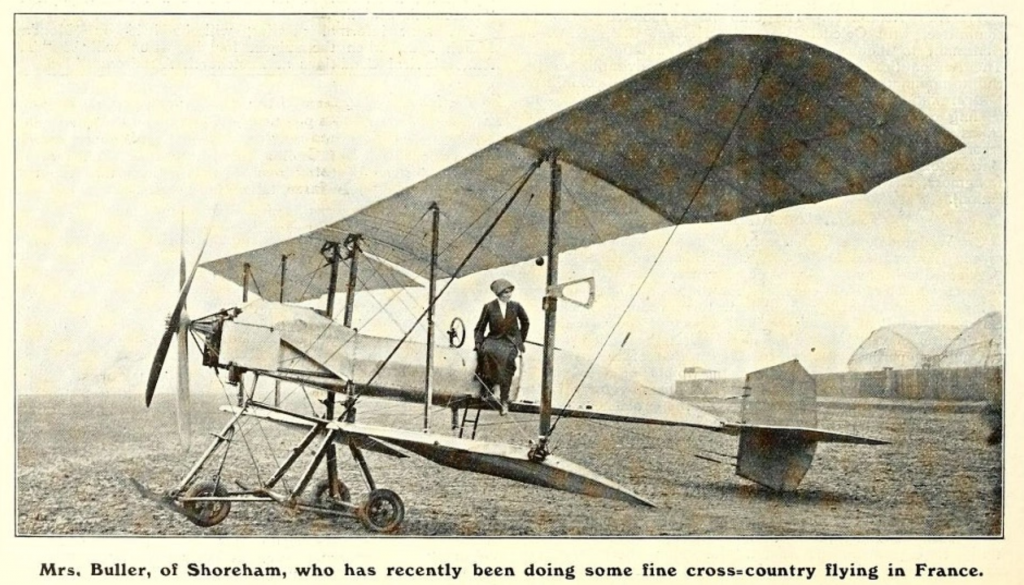
In The Aeroplane magazine of 21st March 1912, a half page spread was devoted to lady aviator, Mrs Winifred Buller, whose husband, George Cecil Buller, was Managing Director of the Shoreham and Lancing Land Company. The article was entitled:- ‘A British Sportswoman‘ :-
A fine example of British sportsmanship is that of Mrs Buller, whose husband owns a number of popular bungalows at Shoreham. When the Comte de Montalent was over here with the Breguet, Mrs Buller made several flights with him, and was so taken with the machine that she resolved to learn to fly it. Consequently, as her husband had to make a long business tour abroad, Mrs Buller shut up her house, packed her two small sons and their nurse into her car and drove across France to Douai, where she has since been flying. Her apprenticeship was short, for in spite of bad weather she has only been learning seven weeks, and evidently might have taken her certificate some time ago, for last week she made a flight of 100 kilometres across country from Douai to Arras and back, including several detours off the direct route to explore the country. This is certainly the longest cross country flight ever made by a woman. Mrs Buller says that the pupils at Douai have such confidence in the stability of their machines when in the air, and in the way they are protected in case of a smash, that they go out in all sorts of weather. Soon after her big cross country flight, Mrs Buller herself flew in to the wash of the Comte de Montalent’s machine and came down with quite a nasty bump, but absolutely without damage to herself. She is a firm believer in the sense of sitting behind the engine and inside a proper protective body.
Winifred Buller went on to attain her flying certificate on the 3rd May 1912 while in France
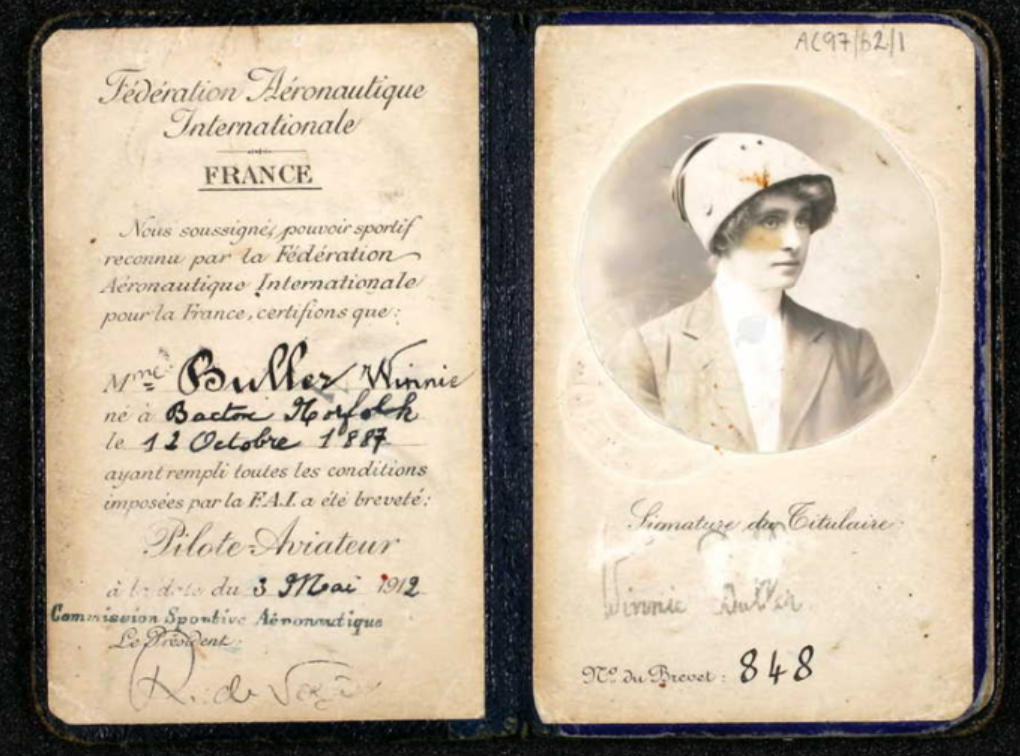
Brighton Gazette Saturday 24th August 1912
Shoreham to Southampton
M. Salmet’s Daring Flight
M. Salmet left the aerodrome at Shoreham on Wednesday night to fly to Southampton. It was a very daring deed, for the weather conditions were rough and boisterous, and the aviator obviously ran great risk in starting. He passed over Worthing at about 6.40, and caused considerable excitement, as it was seen that the machine was battling against a strong wind, and making an unsteady up and down course. It looked as though the aviator might descend to the west of Worthing, but the machine rose again. Later M. Salmet encountered quite a hurricane and a deluge of driving rain, and was forced to descend near Angmering. A great crowd of people who were waiting the aviators arrival at Southampton were disappointed. It was about seven o’clock when Salmet landed near Angmering, and naturally, in a quiet country village, the unexpected arrival created the greatest possible interest. M. Salmet said he was not afraid of the wind, but it was the rain that forced him to descend. The decent was made in a field to the north of Normanhurst, Rustington. M. Salmet resumed his journey by air to Southampton on Thursday morning, leaving at 5.30.
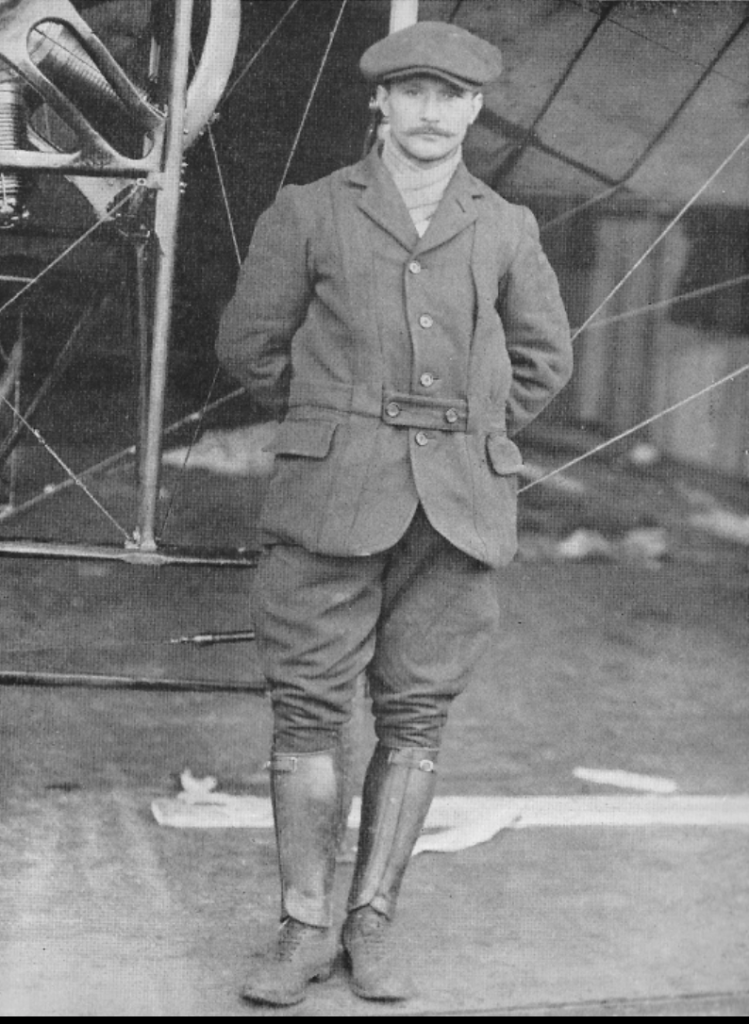
Robert Bertram Slack’s 500 mile tour of the south of England by Bleriot monoplane with Gnome engine. Following on from his hugely successful 1100 mile tour of Great Britain, starting at Hendon Aerodrome on the 15th June
Sevenoaks Chronicle and Kentish Advertiser. Friday 21st June 1912
An Air Tour of Great Britain
The tour of Great Britain by a British Aviator, Mr. Robert Slack, who started from the Hendon Aerodrome on June 15th, is arousing very great interest not only among aviators, but also among the general public. The tour has been organised by the International Correspondence Schools, and is undertaken as a means of educating the public to an understanding of the vast strides that have been made in the science of aviation.
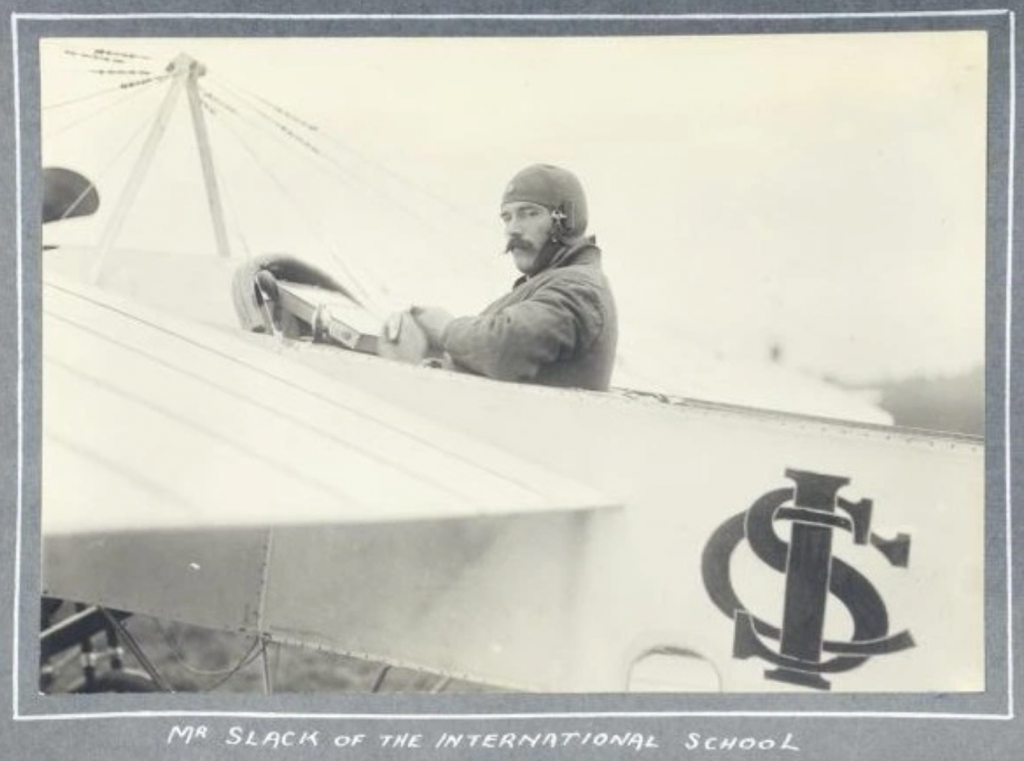
Daily Herald Saturday 31st August 1912
Southern Aeroplane Tour
Mr Robert Slack, the aviator who is on a 500 mile tour of the south, in connection with the International Correspondence Schools, arrived at Smitham Downs, between Purley and Coulsden, yesterday afternoon. Afterwards he continued his flight in the direction of Brighton. Slack reached the Shoreham Aerodrome, near Brighton, a distance of 40 miles, in 32 minutes. He was flying at an average height of about 4,000 feet.
Brighton Gazette Wednesday 4th September 1912
Aviator’s Visit
An aeroplane passing over the Brighton Front on Monday afternoon attracted much attention. It was a Bleriot monoplane, on which the I.C.S pilot, Mr. Slack, was making a flight from the Shoreham Aerodrome to the Race Hill. Starting at five o’clock, he rose to a height of 1,500 feet near Lancing College, and then made his way via Bungalow Town, and kept right along the seafront to Brighton. Nearing the Palace Pier, Mr. Slack came down to a lower elevation, and this gave the thousands of spectators along the promenade a better view of both the aviator and his machine.
After flying round the Pier he steered for Black Rock, and turning, headed for the grand stand on the race course, near where it had been arranged that he should alight. Planing down several hundred feet he found the position of the ground awkwardly situated for the descent, and, restarting his engine, he circled the hill several times to enable him to select the best direction for alighting under the difficult conditions. By careful judgement he eventually succeeded in descending. By this time a great crowd had assembled, including members of the Brighton Corporation, I.C.S students, the Brighton staff of the International Correspondence Schools, all shewing their appreciation of his performance in an enthusiastic manner.
During his stay of about 20 minutes, the people had an opportunity of viewing the machine, and meanwhile Mr. Slack was busily engaged with inquiries about his previous circuit of 1,150 miles of Great Britain, and he signed numerous autographs. Thanks to the able assistance of the police, Mr. Slack had no difficulty in mounting his machine and preparing for the return to the hangar at Shoreham. He left the Race Hill in fine style and steered in a north-westerly direction, which afforded an excellent view to the people in neighbouring places. Nearing Portslade he made for the sea, and kept to the coast. Turning in at Shoreham over the Norfolk Bridge, he descended gracefully near the hangar within the Aerodrome. The weather conditions during Mr. Slack’s flights were by no means favourable, gusty wind varying from 15 to 30 miles per hour, making aviation by no means easy, as was apparent from the way his machine swayed at times.
Flights at Shoreham
Mr. Robert Slack made two magnificent flights from the Shoreham Aerodrome on Saturday afternoon. After circling the aerodrome several times in a masterly manner, he headed for Worthing, and, working round via the Lancing Carriage Works at a height of about 1,000 feet, he then made for Shoreham again, changing his course easily, in spite of the strong rear wind, which had accelerated his travelling speed to about 85 miles per hour. Reaching the aerodrome he alighted amid the applause of a large number of I.C.S students, friends, and prominent local visitors. A second satisfactory flight was made shortly after, in the direction of Hove, returning by way of the Dyke, and before landing the I.C.S aviator gave a demonstration of vol-planing which delighted the spectators. Several students at this stage expressed an enthusiastic desire to accompany him on future occasions.
It is interesting to note that Mr. Slack will remain for some little time, and will carry out a varied programme from day to day, visiting most of the local centres of the I.C.S students, including Brighton, Worthing, Bognor, Eastbourne, Lewes, etc.
Flight Magazine note the arrival of Avro at Shoreham. 28th September 1912
Avro School Goes South
The Avro School, which has hitherto been located at Brooklands, has secured new quarters at the Shoreham Aerodrome, near Brighton. They are going still further south as, following an order from the Portuguese Government, it is intended to found an Avro School in Portugal.”
West Sussex Gazette 24th October 1912
It is remarked in a journal dealing with aviation that the flying ground at Shoreham will probably be the scene of considerable activity this winter. Mr A.V. Roe, a well known aeroplane constructor, is moving his flying school there, and there has been some talk of utilising the river Adur, which flows at a distance of less than a hundred yards from the hangars, for conducting experiments with hydro-aeroplanes. Near one corner of the aerodrome, which is surrounded by a high fencing of corrugated iron, so that the frugally minded cannot remark what is taking place within, stands Old Shoreham Bridge. This very picturesque structure still survives.
Oscar Morison marries daughter of Bungalow Town residents, Howard and Annie Cleaver
Brighton Gazette Wednesday 27th November 1912
FAMOUS AVIATOR WEDDED
Yesterday the wedding took place at St. Peter’s Church, Brighton, of Mr. Oscar C. Morison, the famous aviator, who was the first to fly to Brighton. His bride was Miss Marguerite Valerie Cleaver, of Shoreham and London. A great deal of local interest was evinced in the wedding, which was also attended by a large number of guests. After the ceremony, which was fully choral, the church being charmingly decorated with palms, variegated foliage and white chrysanthemums, a reception was held at the Royal Albion Hotel, where Mr. Morison made his residence during his flying expeditions here. Some 100 guests were received in a profusely decorated lounge.
Fellow aviator, James Valentine, was a witness to the marriage, and aviators friend, Harry Preston, entertained the guests at his Royal Albion Hotel afterwards. Also, Oscar’s new brother in law, Digby Cleaver, living at Bungalow Town with his parents, was the first Boy Scout to fly in an aeroplane. The Cleaver’s lived at Coronation bungalow while in Shoreham.
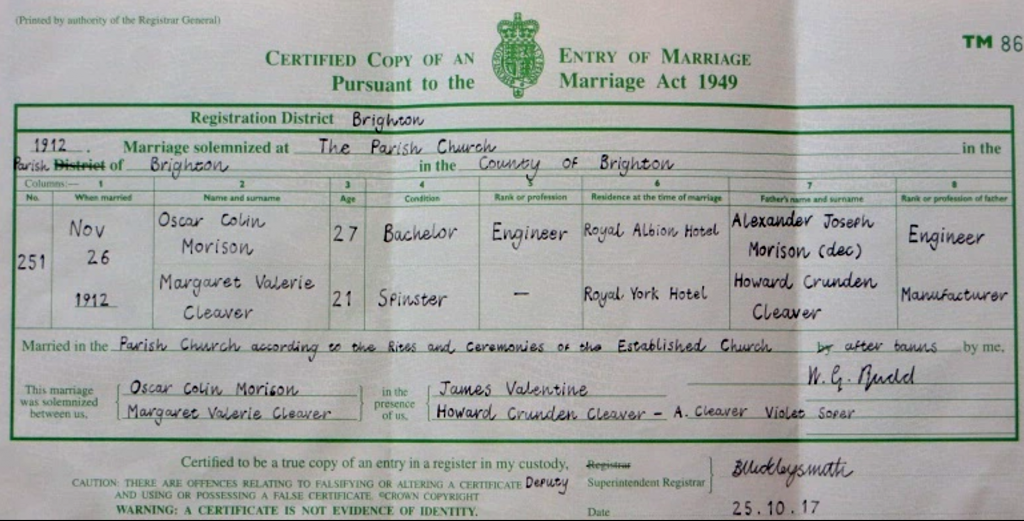
Andy Ramus 2021
For the additional article chapters follow the links:

